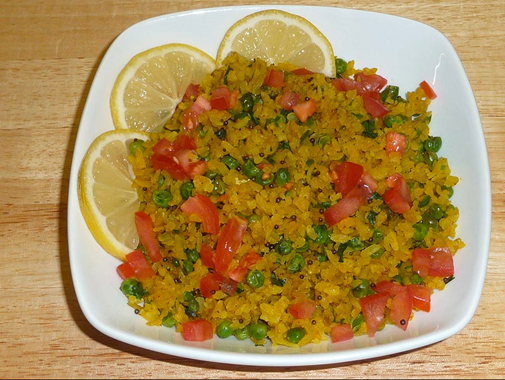Mama’s Punjabi Recipes: Chivda Gobi Mutter (Flattened Rice Snack)
Finding the right things to snack on can be a frustrating thing – it’s either too sweet, like chocolate or too plain like tortilla chips and salsa; and Lord knows Punjabis like to snack! Finding the right combination that can not only be satisfying between meals but filling without putting on calories can be a tricky proposition.
Fortunately, there are some options, like the Gujarati dish chivda which has become quite popular in North India too. There are many forms of chivda made across India – like makai (corn kernels), South Indian murmura, bhajlela (Marathi yellow chana bulk), corn flakes, oats, potato, sweet, mixed dry fruit and spicy chivda – and these mostly use the thick poha (flattened, dry rice) readily available in supermarkets.
In the Punjab, chivda is both the dish and the dehusked rice, flattened into flat light dry flakes used to make it. But in other parts of India, the flakes are called poha. They come in the more expensive, thin, almost translucent type or the fatter, nearly four times the thickness of normal rice. When added to a liquid they swell up and are easily digestible. Poha is popular across India, Bangladesh and Nepal where it is used to prepare snacks and fast foods. Poha can also be eaten with plain water or milk, with salt or sugar to taste, or lightly fried in oil with nuts, raisins, coconut, cardamom and spices.
This chivda recipe is for a quick snack that can eaten with chai (tea) and is made with mutter (peas) and phul gobi (cauliflower) – or simply gobi – a favorite vegetable among Punjabis. When mixed with dahin (yogurt) or acchar (pickles), it can even be eaten for lunch or a light dinner. And if mixed with tamater (tamotoes), chopped piyaaz (onions) and dhania (coriander) leaves, it can be eaten as a cold salad. It is made with very little oil and spices, and once you start, you won’t be able to stop eating it!
Ingredients:
2 cups poha (thicker type flattened rice) – serving is for 4 people
1 cup phul gobi (cauliflower)
1 cup mutter (peas) – frozen or fresh
1 tbsp tael (olive oil or vegetable oil)
¼ tsp sarson til (mustard seeds)
Spices (to taste): namak (salt), mirch (red pepper), haldi (turmeric), amchoor (ground green mango powder)
Directions:
1. Put the poha in a bowl of water and let it soak for 20 minutes. Then run it through a strainer to drip.
2. Remove the outer stalks of the gobi and then cut off the florets.
3. Cut the florets into fine small pieces. Peel the potatoes and cut into fine pieces. Place both in a strainer, wash and then let them drip dry.
4. Take the frozen peas out of the freezer and let them thaw out.
5. Heat the oil in a karai or wok over medium high. Throw in the mustard seed and let it roast for 30 seconds, then add in the haldi and stir.
6. Now add in the gobi, potatoes and peas. Mix well and cover over medium heat for 2 or 3 minutes.
7. Remove the cover and add the drained poha. Add the salt, pepper and amchoor to taste and mix. Let it cook for 2 minutes, stirring occasionally.
8. Serve in a plate by itself or with yogurt or pickles.
MAMA’S TIP OF THE WEEK
FOLD THE ATTA TO MAKE SOFTER PARANTHAS
Who doesn’t like those delectable Punjabi paranthas? The final answer often depends on how the paranthas are made. Some restaurants make paranthas that have the right color and size even, but one bite into them and you realize they are thin and tough. Others make them just too crisp and hard with lots of oil. Yet others make them soft and rubbery.
Even homemade paranthas can have the same problems, though the most common complaint is that they are too limp and uneven. The secret is not just in making the dough; it is also in the way the dough is rolled out. After the first roll, you must fold over the pancake twice to make a rectangle and then fold the rectangle in four fold into a square. Now roll in out again into a pancake and throw it on the tava. You’ll see the parantha will come out softer.

Shakuntla Malhotra is a skilled cook of Punjabi dishes made in the old-fashioned style that she learnt as a young woman in her ancestral home in Lyallpur (since renamed Faisalabad), India before it became part of Pakistan after the Partition in 1947. People have often admired her cooking for its simplicity and taste that comes with each mouthful. Even in her mid-eighties, she continues to cook daily and agreed to share some of her delectable Punjabi recipes.

